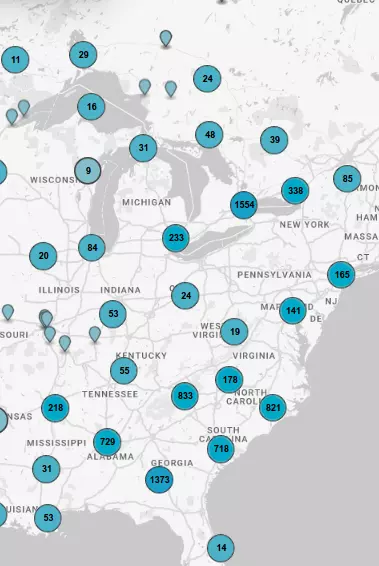St. Andrew's Cemetery
At the end of this avenue, on high land overlooking the creeks and marshes, Thomas Spalding of Sapelo established his family burial ground. For many years the Spaldings and their kinsmen were...
- lat34
Fort Barrington
Fort Barrington, about twelve miles west of here on the Altamaha River, was built in 1751. Lieut. Robert Baillie, in charge of construction, commanded the post for several years. Named Fort Howe...
- lat34
Baisden's Bluff Academy
Located a short distance East of here, near the River, Baisden´s Bluff Academy was the main educational institution in McIntosh County in the early years of the 19th century. A Boarding School,...
- lat34
The McIntosh Family of McIntosh County
The service of this family to America, since the first of the Clan, with their leader, Captain John McIntosh Mohr, came from the Highlands of Scotland to Georgia, in 1736, forms a brilliant...
- lat34
Site of Early Spanish Mission
This high bluff was the site of one of the early Spanish Missions of the Old District of Guale. Here, in the late 16th and the 17th centuries, Franciscan friars labored with the...
- lat34
Famous Butler Authors
Pierce Butler and his daughter, Frances, who shared his interest in the South, returned to Butler island in 1866, and worked to rehabilitate the plantations. Pierce Butler died in 1867,...
- lat34
Site of Bank of Darien
The old Bank of Darien, in its day the strongest Bank South of Philadelphia, was organized in 1818 with a Capital Stock of $1,000,000. The first Directors on the part of the State were:...
- lat34
Saint Andrew's Episcopal Church
Saint Andrew´s Episcopal Church in Darien received its charter in 1843, under the Rt. Rev. Stephen Elliott, first Bishop of the Diocese of Georgia. The church edifice, a large wooden building with...
- lat34
200 Years of Sawmilling
For nearly two centuries the story of sawmilling in the Southeast was enacted on this point on the Altamaha River. In the summer of 1721, men from South Carolina sawed the 3-inch planks to...
- lat34
Fort King George
1 mi. The site of fort King George, the first fort on Georgia soil built by the English. Erected by the Colony of south Carolina in 1721, 12 years before the Georgia Colony was founded. This...
- lat34
McIntosh County
This county, created Dec. 19, 1793 from Liberty County, was named for the McIntosh family, early settlers, whose name was associated with most events in Georgia history for many years....
- lat34
Colonel John McIntosh
About one mile from this spot, at Fairhope, the adjoining plantation, Colonel John McIntosh, hero of the american revolution, was buried in 1826. It was Colonel McIntosh, in command of Fort Morris...
- lat34
Captain William McIntosh
In this plot under the ´Great Oak at Mallow Plantation,´ Captain William McIntosh, father of the Indian chief, General William McIntosh, was buried in 1794. Captain McIntosh an officer in...
- lat34
Hickory Hill
Populist presidential candidate and Georgia political leader Thomas E. Watson purchased this house from Captain James Wilson 1900. Watson extensively renovated both the house and...
- lat34
Home of Thomas E. Watson 1856-1922
After passing the state Bar in 1876, native Thomas E. Watson returned to Thomson and lived in this house with his family from 1881 to 1900. In his first floor office Watson began his law...
- lat34
Usry House
Built by William Usry about 1795 as the seat of his extensive cotton plantations, Usry House early became the center of ante-bellum social life in this region. In its parlor, the...
- lat34
William Bartram Trail Traced 1773-1777
Deep South Region, William Bartram Trail, Traced 1773 - 1777. 1773 the Treaty of Augusta Bartram visited Wrightsborough. He described the view of high hills and rich vales. He took on...
- lat34
The Rock House
This 18th century dwelling is the only surviving house associated with the Colonial Wrightsboro Settlement (1768). Its builder, Thomas Ansley, used weathered granite, quarried in its natural form...
- lat34
The Birthplace of George McDuffie
From these humble and obscure Georgia pinelands, assisted by the plantation-owning South Carolina Calhouns, George McDuffie rose to become Congressman, Senator, and Governor of South Carolina....
- lat34
Wrightsboro
On this site in 1754, Edmund Grey, a pretending Quaker, founded the town of Brandon, named for one of its leaders. In Dec. 1768, Joseph Mattock and Jonathan Sell, Quakers, obtained a grant of...
- lat34
